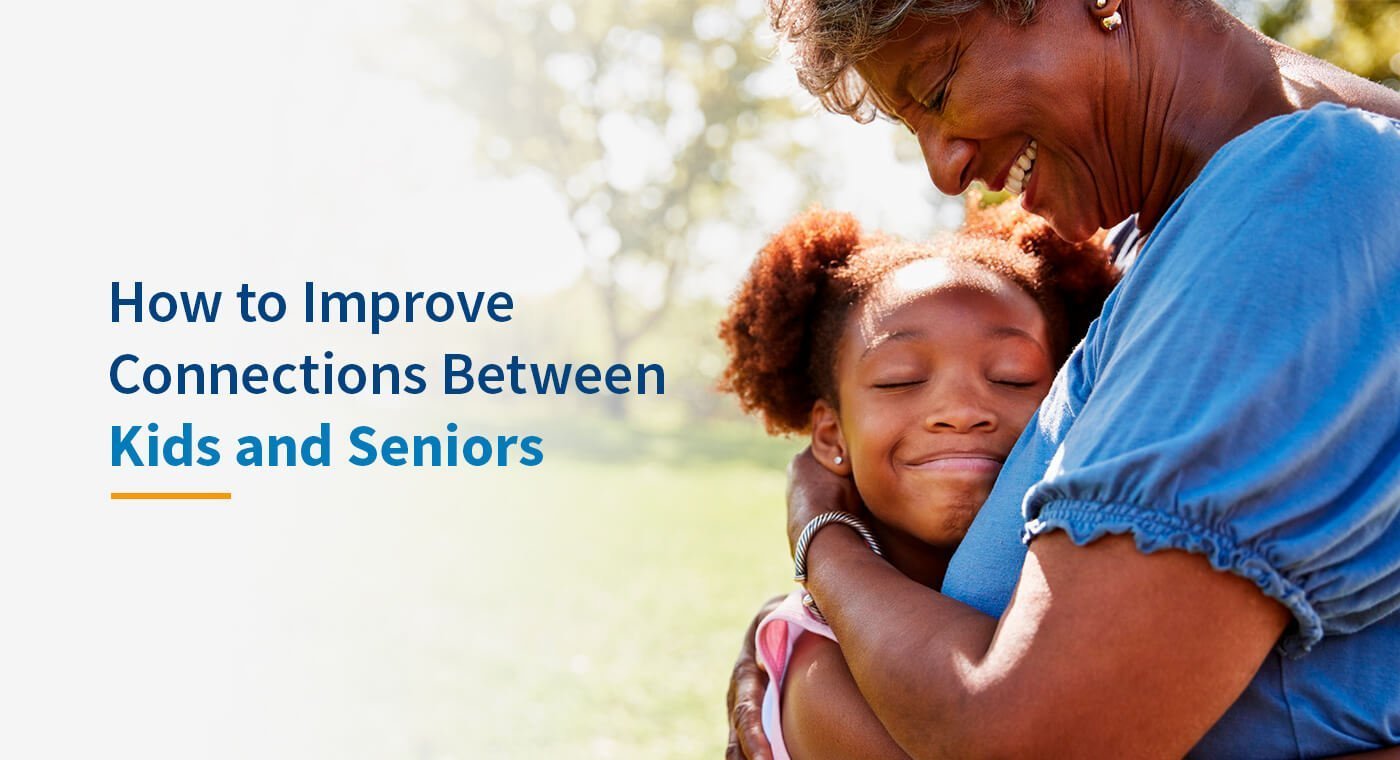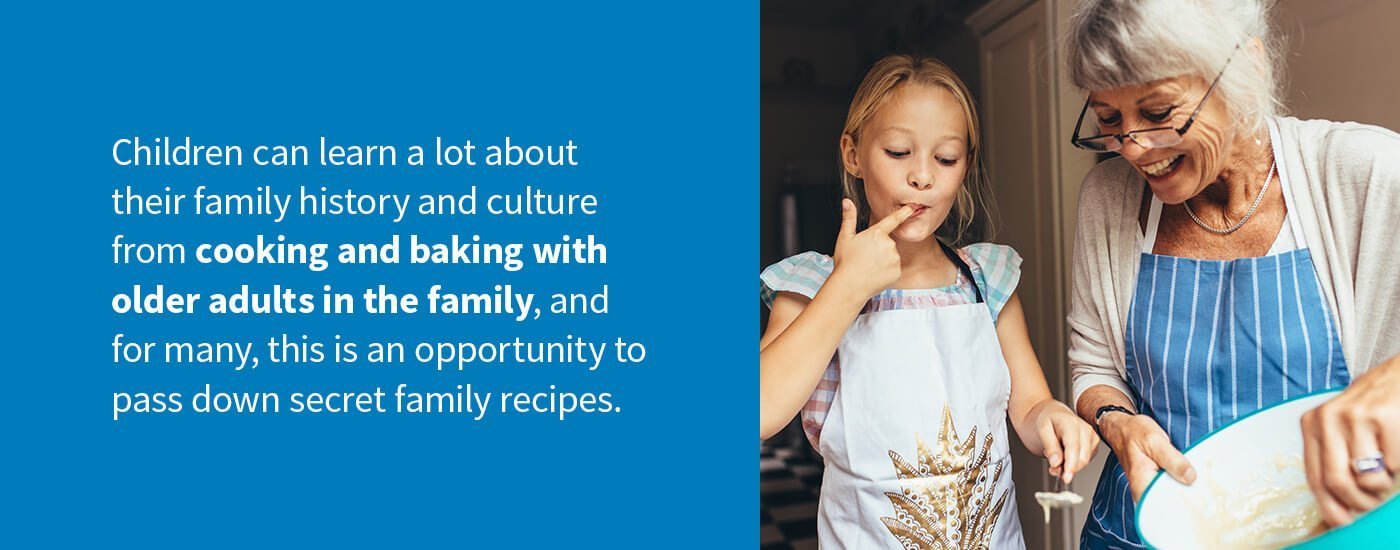How to Improve Connections Between Kids and Seniors
If you’re wondering how to connect kids and seniors, this guide has many tips on fostering that connection and examples of activities both parties will enjoy. Promoting positive relationships with elderly family members can help kids become more worldly and well-rounded. Older adults have so much to offer their younger counterparts, and connecting them can benefit both sides.
It’s always a good idea to plan activities for seniors and children to engage in. While older adults and children are different, they often have a lot in common as well. Both groups enjoy having fun and spending time with family members. Even if kids don’t live within an accessible distance of older adults in their family, plenty of programs promote intergenerational activities and learning. Some communities have even begun experimenting with day care at senior care facilities to increase enjoyment for both parties.
Importance of Connecting Kids and Seniors
Having a close, long-term relationship with an older adult brings enormous benefits to children, including higher self-esteem and confidence. Connecting kids and seniors on a meaningful level increases the quality of life for both parties and can have demonstrated impacts on children’s futures. Older adults who spend time with their grandchildren get to enjoy all the benefits of parenting without a full-time commitment. Often, this means they can provide more undivided attention, which is essential for children’s growth and development.
Benefits for Seniors
Seniors who build connections with kids can reap many rewards. Spending time with children can promote a more active and happy lifestyle. Here are a few other benefits of intergenerational activities for seniors.
1. Increasing Quality of Life
When older adults spend time with kids, it can improve their quality of life. As we age, we might lose some abilities that help us enjoy an active life. Depression is typical in seniors, especially those isolated from their families or in senior care facilities where they don’t interact much with the outside world. Connecting with kids can increase older adults’ excitement about life and decrease levels of isolation and depression.
The secret to increasing older adults’ quality of life is promoting activities they will look forward to. Doctor’s visits, medications and even mealtimes can be challenging for those who have lost a measure of their independence. Planning activities that they will look forward to, such as spending time with kids, is crucial.
2. Energizing Older Adults
Another benefit of intergenerational activities is that they can energize and invigorate older adults. Often, spending time with kids can inspire them to be more active than they would otherwise. It might encourage them to walk, swim in a pool or even ride bikes. Exercise is vital for older adults, so spending time with children is a great way to promote a more active lifestyle.
Aside from physical activity, intergenerational bonding also encourages older adults to view their life differently. Spending time with children can help them forget their limitations and might even make them feel more confident and capable.
3. Teaching New Skills
Connecting kids and the elderly helps each learn new skills. Older adults often benefit from increased knowledge of technology when they spend time with children. Many kids love playing games on their phones or tablets, which they can teach older adults how to do. Often, these games have the added benefit of helping older adults exercise their fine motor skills.
Sharing online games and activities can improve older adults’ facility with technology to make staying in contact with their families easier. Many young people prefer to text or video call over traditional calling, and being comfortable with these abilities ensures older adults stay in touch with their children and grandchildren.
4. Sharing Life Experiences
Another of the benefits of connecting youth and seniors is that it lets older adults share their life experiences. Storytelling and life lessons are crucial ways for older adults to connect with younger generations. When older adults can share the wisdom they’ve learned throughout their life with younger generations, they feel more connected to them.
Sharing life experiences can help older adults feel like they are creating a legacy that will persist long after they are gone. Families pass down stories from generation to generation, so these are essential to building relationships with kids and seniors.
Benefits for Kids
Kids can also benefit from spending time with older adults. Studies show that, on average, children need about four to six involved adults in their lives to develop social and emotional skills. Promoting and encouraging grandchild-grandparent relationships can have benefits for children.
1. Keeping History Alive
Every family has a unique culture and heritage. By listening to accounts of their family history, children get a better sense of where they come from and their family roots. When grandparents spend time with their children and grandchildren, they can impart personal wisdom and pass down beliefs and values. In turn, children enjoy partaking in these essential family traditions and rituals.
Even without familial bonds, children can learn a lot from older adults who experienced significant historical events. Hearing firsthand accounts of things they learn about in school is an excellent way to instill lessons and wisdom based on the real-life experiences of people who experienced them.
2. Learn New Skills
While older adults can learn about technology through spending time with children, kids learn new skills too. Older adults often have skills and hobbies they can pass on to younger generations. Something as simple as embroidery or knitting to something as significant as cultural practices are fantastic skills children can learn from spending time with seniors.
Children may pick up new interests and hobbies from being exposed to older adults and learning from them. These skills may take them far in life, and they can pass the pastimes they learn from older adults on to their children.
3. Reduces Misconceptions About Aging
When kids spend time with older adults, it can reduce the stigma surrounding aging and older adults. Interacting with grandparents and other seniors can teach children how to treat older adults with respect.
Spending time with older adults can also help dispel typical stereotypes about aging, including what older adults are capable of. Many people may fear getting older or think older adults can’t have fun or enjoy life. However, having children bond with older adults can promote positive views of seniors and dispel children’s fears that older adults can be mean or scary.
4. More Undivided Attention
When kids spend time with older adults in their family, such as staying with their grandparents over the weekend, they get more attention than they would from parents who might be busy with work and family responsibilities. Having more trusted adults in a child’s life means they have more people to rely on.
In many families, grandparents play a critical role in looking after young children while parents are at work. However, once children enter school, their role in caretaking often diminishes significantly. Keeping older adults involved in children’s lives for as long as possible has enormous benefits for them and the child. Including more positive role models in children’s lives is essential to help them thrive.
Tips for Connecting
There are some simple tips for fostering connections between children and older adults. Parents can coach their children on how to act with older adults around and how they may need to treat them differently than they would their parents.
- Listen carefully: Many older adults have great stories and jokes, but children must learn to pause and listen. Older adults communicate differently than children do, and they may speak quietly or have difficulty talking. Listening carefully to older adults ensures they feel heard.
- Speak clearly: Explain to children that some older adults may have impaired hearing, so in conversation, they should enunciate and speak up, but not yell. They might need to repeat themselves, but explain that patience is a virtue.
- Be gentle: Younger children, especially, may play rougher than older adults can handle. Explain to children that older adults are more sensitive to loud noises and may get hurt easily. Telling children to be gentle around older adults can help both parties have a safe time together.
- Ask questions: A great way to foster connections between older adults and kids is to encourage curiosity. Tell them to ask their grandparents and other seniors about their life and any stories they have. It may also be helpful to ask respectful questions about their experience as older adults to dispel any misconceptions about aging.
- Be respectful: Teach children that they still need to be respectful even though they can play with older adults. Older adults may have different boundaries and preferences than children are used to with their parents, so it’s crucial to respect their wishes.
Activities to Improve Connections Between Generations
Spending time together is essential to fostering parent-child relationships, but it’s also vital to do activities with older adults in the family to improve connections between generations. The following are examples of fun activities for children and seniors to do together.
1. Arts and Crafts
Arts and crafts are an excellent introductory activity to get older adults and children to connect. Many older adults don’t have as many opportunities to express their intellect and creativity, but arts and crafts can help them get in touch with their creative side. Kids can also bring out older adults’ creativity with their active imaginations.
2. Nature Walks
Something as simple as a walk in nature can foster connections between kids and seniors. Find a park or forest with accessible trails and go on a nature walk. Many websites designate which trails are wheelchair-accessible if that’s a safer option for the older adult in the group. Just be sure to bring plenty of water and snacks.
3. Bird-Watching
While some children may initially bristle at the idea of sitting quietly and watching for birds, it can be an incredibly enriching activity, and one in which older adults can easily participate. If they already enjoy bird-watching, they might be able to teach kids about the different types of birds they see and their migration patterns.
4. Cooking and Baking
If a kid finds interest in cooking or baking, that’s a fantastic opportunity to involve a grandparent or older adult. Children can learn a lot about their family history and culture from cooking and baking with older adults in the family, and for many, this is an opportunity to pass down secret family recipes.
5. Puzzles and Board Games
Sometimes it’s nice to put down the smartphone or tablet and solve a puzzle or play a board game. It’s a wonderful activity for children to partake in with older adults, and it can stimulate their brains in different ways than playing on a screen would.
6. Storytime
Children often love storytime and become engaged with tall tales and fantasy worlds. Older adults often spend quite a bit of their time reading, so this is a great activity for them to engage in together. Older adults can read children’s favorite books, or come up with stories of their own to tell. Kids often love to hear about their parents’ lives and learn about their family’s history this way.
7. Swimming
Another active pursuit children and adults can enjoy together is swimming. The weightlessness of the water will make it easier for older adults to move around and have fun with children. In addition to being great exercise, swimming is also a fun activity kids love, and sharing it with an older adult can make the experience more enjoyable.
About CareGivers of America
Improving quality of life is an essential element in senior care. According to a study by Pew Research Center, 27% of adults 60 and older live alone in America, which is almost twice as many as in other countries. Other cultures place a more significant role in intergenerational homes, in which three or more generations may live under the same roof. Since many older adults live alone, it’s crucial to ensure they maintain their independence as much as possible while still getting the care they need.
Having children spend time with older adults can help them feel less isolated and more energized, but it’s also valuable to have assistance with aspects of daily living. That’s where CareGivers of America comes in. If an older adult in your life needs help with things like housekeeping, cooking, laundry and errands, we can refer qualified caregivers to provide these essential home care services.
We differentiate ourselves from other senior care services with our careful selection process. Our team of dedicated experts will help you choose a caregiver to match your family member’s exact needs and will remain on call 24/7. Additionally, all our caregivers undergo extensive background screenings.
We’ll perform a free home visit to discuss any questions and concerns you might have, and our caregivers can be available immediately. Contact us today to begin the process of choosing a dedicated, professional caregiver for your loved one.









